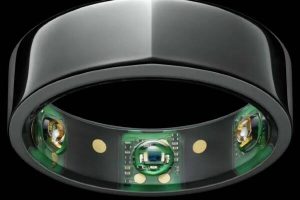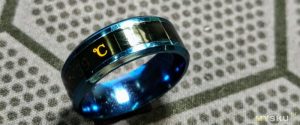A temperature measuring ring works based on the principle of thermocouples. A thermocouple is a device that generates a voltage in response to a temperature difference between its two ends. The voltage generated by the thermocouple is directly proportional to the temperature difference between its ends, which can be used to determine the temperature of the object being measured.
In the case of a temperature measuring ring, the ring is made of a thermocouple material such as nickel-chromium or platinum-rhodium. When the ring is placed around an object or in an environment, one end of the ring is exposed to the temperature being measured while the other end is maintained at a known temperature, usually by connecting it to a reference temperature source.
The temperature difference between the two ends of the thermocouple generates a voltage, which is proportional to the temperature being measured. This voltage can be measured using a voltmeter, and the temperature can be calculated using a thermocouple temperature conversion table or equation.
It’s worth noting that the accuracy of temperature measuring rings depends on various factors such as the quality of the thermocouple material, the size of the ring, and the placement of the ring around the object being measured. Calibration of the ring is also crucial to ensure accurate temperature readings.
How accurately does it show the temperature
The accuracy of a temperature measuring ring can vary depending on several factors such as the quality of the thermocouple material, the size of the ring, and the placement of the ring around the object being measured.
Generally, temperature measuring rings can provide high accuracy temperature measurements, particularly when the ring is calibrated correctly. The accuracy of the temperature reading is typically within +/-1°C or better.
However, it is important to note that the accuracy of temperature measuring rings can be affected by various factors such as external factors that may affect the temperature being measured, the placement of the ring, and the use of incompatible materials. Therefore, proper calibration and placement are essential to ensure accurate temperature readings.
It is recommended to calibrate the temperature measuring ring regularly and follow the manufacturer’s instructions for proper use to achieve the best possible accuracy.
How to determine the size
The size of a temperature measuring ring depends on the size of the object or environment that needs to be measured. The ring should be able to fit snugly around the object or in the environment without being too loose or too tight.
To determine the appropriate size of the temperature measuring ring, you can follow these steps:
- Measure the diameter or circumference of the object or environment that needs to be measured using a tape measure or caliper. If the object is not circular, measure its widest point.
- Add a small amount of extra space to the measurement https://www.buydo.eu to account for any insulation or material that might be placed between the ring and the object being measured.
- Choose a temperature measuring ring with a diameter or circumference that is slightly larger than the measurement obtained in step 2.
- Ensure that the thickness of the ring is appropriate for the temperature range being measured and the accuracy required.
It is also important to note that some temperature measuring rings come in adjustable sizes or with adjustable inserts that can be modified to fit different objects or environments. In such cases, you can adjust the ring to fit the object or environment as needed.

How to use
To use a temperature measuring ring, follow these general steps:
- Choose a temperature measuring ring that is appropriate for the temperature range being measured and the accuracy required.
- Calibrate the ring according to the manufacturer’s instructions or industry standards to ensure accurate temperature readings.
- Place the temperature measuring ring around the object or in the environment that needs to be measured. The ring should be placed as close as possible to the area where the temperature needs to be monitored.
- Connect the thermocouple leads to a temperature measuring instrument, such as a voltmeter or digital thermometer, according to the manufacturer’s instructions.
- Turn on the temperature measuring instrument and allow it to stabilize for a few minutes to ensure accurate readings.
- Read the temperature displayed on the temperature measuring instrument. If necessary, use a thermocouple temperature conversion table or equation to convert the voltage reading to a temperature value.
- If the temperature needs to be monitored continuously, leave the temperature measuring ring in place and record temperature readings at regular intervals.
- Remove the temperature measuring ring when it is no longer needed.
It is important to note that the accuracy of temperature readings may be affected by various factors such as the quality of the thermocouple material, the placement of the ring, and any external factors that may affect the temperature being measured. Therefore, it is essential to calibrate the temperature measuring ring and use it properly to ensure accurate temperature readings.
Additional functions
While temperature measuring rings are primarily designed for measuring temperature, some models may have additional functions or features. Here are some examples:
- Data logging: Some temperature measuring rings may have the ability to store temperature readings over time, allowing users to review and analyze temperature trends.
- Wireless connectivity: Some temperature measuring rings may be equipped with wireless connectivity, allowing users to monitor temperature readings remotely or transmit data to other devices.
- Alarm or alert settings: Some temperature measuring rings may have programmable alarm or alert settings that can notify users when temperature readings fall outside a certain range.
- Display: Some temperature measuring rings may have a built-in display that shows temperature readings in real-time.
- Compatibility with software: Some temperature measuring rings may be compatible with specialized software that allows for advanced data analysis and visualization.
It is important to note that additional functions or features may vary depending on the model and manufacturer of the temperature measuring ring. Before purchasing a temperature measuring ring, it is essential to evaluate which features are necessary for your specific application and choose a model that best meets your needs.
Pros and cons
Here are some of the pros and cons of using a temperature measuring ring:
Pros:
- Non-contact measurement: Temperature measuring rings can be used to measure the temperature of an object or environment without physically contacting it, which can be useful for measuring delicate or hard-to-reach objects.
- High accuracy: Temperature measuring rings can provide high accuracy temperature measurements, particularly when the ring is calibrated correctly.
- Durable: Temperature measuring rings are typically made of sturdy materials that can withstand high temperatures and harsh environments.
- Portable: Temperature measuring rings are relatively small and portable, making them convenient for fieldwork or mobile applications.
Cons:
- Limited measurement range: Temperature measuring rings have a limited temperature range that they can measure accurately, depending on the type of thermocouple material used.
- Placement sensitivity: The accuracy of temperature measuring rings can be affected by the placement of the ring around the object or in the environment being measured. Improper placement or contact with other objects may cause errors in temperature readings.
- Slow response time: Temperature measuring rings may have a slower response time than other temperature measuring devices, particularly when measuring rapidly changing temperatures.
- Calibration required: Temperature measuring rings need to be calibrated regularly to ensure accurate temperature readings, which can be time-consuming and require specialized equipment.
In summary, temperature measuring rings are a useful tool for measuring the temperature of objects or environments, particularly in situations where non-contact measurements are necessary. However, they have limitations, and proper calibration and placement are critical to ensure accurate temperature readings.
How to take care
Proper care and maintenance of a temperature measuring ring can help ensure its longevity and accuracy. Here are some tips for taking care of a temperature measuring ring:
- Store in a safe place: Store the temperature measuring ring in a dry, cool place, away from any sources of moisture or extreme temperatures. If the temperature measuring ring is not being used for an extended period, store it in a protective case.
- Clean regularly: Clean the temperature measuring ring regularly to remove any dirt or debris that may affect its accuracy. Use a soft cloth or brush to clean the thermocouple wire and the ring, and avoid using abrasive materials that may damage the ring or affect its calibration.
- Calibrate regularly: Calibrate the temperature measuring ring regularly to ensure its accuracy. Follow the manufacturer’s instructions for calibration, or refer to industry standards for proper calibration procedures.
- Handle with care: Handle the temperature measuring ring with care to avoid damaging the thermocouple wire or the ring. Avoid bending the thermocouple wire or placing any undue stress on it.
- Avoid exposure to extreme conditions: Do not expose the temperature measuring ring to extreme temperatures or conditions that may damage its components or affect its calibration. Avoid exposing the ring to water, chemicals, or corrosive substances.
- Use as directed: Follow the manufacturer’s instructions for proper use and care of the temperature measuring ring. Avoid using the ring for purposes other than measuring temperature, and do not modify or alter the ring in any way.
By following these tips, you can help ensure the longevity and accuracy of your temperature measuring ring, and minimize the risk of damage or inaccurate temperature readings.
